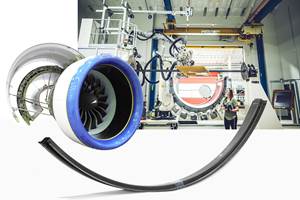Workforce development: Let's start in high school
CW Editor-in-Chief Jeff Sloan says one concern at the otherwise positive initial membership meeting of the new Institute for Advanced Composites Manufacturing Innovation (IACMI) was that the composites industry is quickly losing knowledge, as old-timers retire, that is not so easily replaced. Here's his prescription.
The US Department of Energy’s most recently created consortium, the Institute for Advanced Composites Manufacturin Innovation (IACMI), held its first membership meeting in mid-June in Knoxville, KY, US. It gathered together about 350 people, including academicians, suppliers, fabricators, OEMs and government officials. The two-day event was designed to help members lay the groundwork for the consortium’s operating principles and outlined in broad terms how IACMI projects and research efforts will be evaluated, vetted and executed. It’s still too early to know just how successful IACMI will be, but the mood at the Knoxville meeting was decidedly optimistic.
There was one concern brought up by many speakers, and that was workforce development, which can mean many things, depending on the context, but in general you can think of it this way: We have too many “old” people and not enough “young” people. Basically, rapidly retiring Baby Boomers are taking with them a ton of composites experience and knowledge that is not easily replaced, because the world — and the US, in particular — is not producing enough graduates qualified to replace them. The shortage of mechanical engineers is particularly acute, but I get the sense that an engineer of any stripe will do, so dire is the need.
There are, of course, many schools that offer excellent composites engineering programs, and several were represented at the IACMI meeting, including the University of Tennessee, the University of Delaware, Michigan State University and the University of Dayton. The big question, then, was this: How do we get more college students interested in engineering, and how do we funnel them towards the composites industry?
Our biggest problem, however, might be that the question we’re asking focuses on college students. I suggest that we might be better off thinking more about high school students. I say this for two reasons. First it is in high school, not college, that the best and brightest students begin exploring — in earnest — what their skills are and how and where they can be applied. The best high schools and the best parents help such kids along the way with academic and extracurricular programs that offer hands-on experiences and give kids a taste for what could be. For the engineering-minded, this could be a robotics or bridge-building competition, or how about an internship with a local manufacturer? Second, the cost of a college education has become almost universally onerous. Students and parents can’t afford a meandering, uncertain college career marked by changes of major that risk elevating the cost. A student who has developed an aptitude in high school and has clear career interests wants to know what his or her path will be through college.
Given this, I think the composites industry has an opportunity. Many high schoolers today have available to them a program called “dual enrollment,” where, starting their junior year, they can take classes at a local community college or university, in combination with high school classes. The college classes are typically paid for by the school district, count toward high school graduation and enable the student to earn free, transferable college credit before graduation. Some students actually finish high school with a free associate’s degree, or a certificate for a specific skill, which effectively reduces the time required to earn a bachelor’s degree.
Could IACMI develop a composites-based, dual-enrollment program that would steer students toward a “pre-engineering” associate’s degree? Further, could it combine that with high school internships with composites fabricators to give these kids a taste of the composites life, thereby offering them hands-on experience in a real engineering environment? And finally, could these same kids, after they graduate high school, continue in apprenticeships at composites fabricators while they attend a four-year school and earn that highly coveted engineering degree?
IACMI is composed of the exact mix of composites industry players required to establish such a program, and the geography represented by the consortium members offers a broad area over which we could reach out to students.
It’s just an idea, but one with merit. Let me know what you think.
Related Content
Combining multifunctional thermoplastic composites, additive manufacturing for next-gen airframe structures
The DOMMINIO project combines AFP with 3D printed gyroid cores, embedded SHM sensors and smart materials for induction-driven disassembly of parts at end of life.
Read MoreThe potential for thermoplastic composite nacelles
Collins Aerospace draws on global team, decades of experience to demonstrate large, curved AFP and welded structures for the next generation of aircraft.
Read MorePlant tour: Aernnova Composites, Toledo and Illescas, Spain
RTM and ATL/AFP high-rate production sites feature this composites and engineering leader’s continued push for excellence and innovation for future airframes.
Read More“Structured air” TPS safeguards composite structures
Powered by an 85% air/15% pure polyimide aerogel, Blueshift’s novel material system protects structures during transient thermal events from -200°C to beyond 2400°C for rockets, battery boxes and more.
Read MoreRead Next
Ultrasonic welding for in-space manufacturing of CFRTP
Agile Ultrasonics and NASA trial robotic-compatible carbon fiber-reinforced thermoplastic ultrasonic welding technology for space structures.
Read MoreCeramic matrix composites: Faster, cheaper, higher temperature
New players proliferate, increasing CMC materials and manufacturing capacity, novel processes and automation to meet demand for higher part volumes and performance.
Read MoreScaling up, optimizing the flax fiber composite camper
Greenlander’s Sherpa RV cab, which is largely constructed from flax fiber/bio-epoxy sandwich panels, nears commercial production readiness and next-generation scale-up.
Read More












